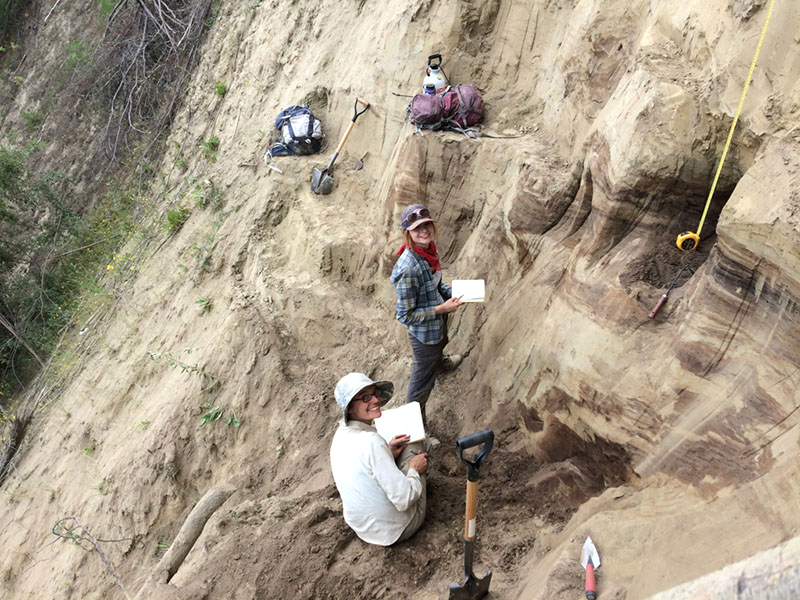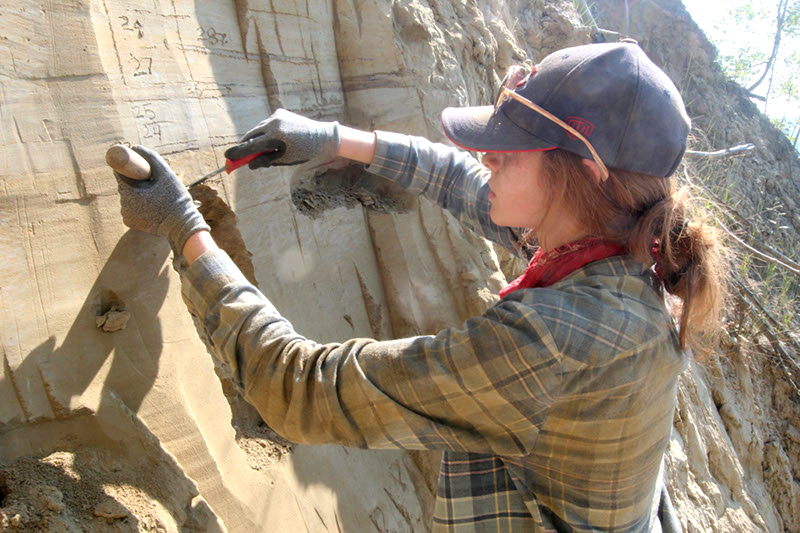
A close-up of the sediment deposits shows many layers of colored material. The light bands consist of wind-driven mud, the so-called loess, while the darker bands also contain ancient soil called paläosol. Photo: Elizabeth Thomas
Scientists are searching for clues about climate change in Canada's gold mines
Scientists are looking for something valuable in gold mines near Fairbanks, Alaska - and it's not metal.
They search layers of ancient sediments for clues as to how the region's climate changed in times of prehistoric global warming. The proof of this lies in the dirt itself, which contains chemical compounds that can reveal whether the region became moister or drier with increasing temperature changes in antiquity.
The ongoing project, funded by a grant from the National Geographic Society, could help researchers and policymakers understand how Alaska could react in the years to come as the planet heats up over time.
It is a topical issue as the state is already feeling the effects of climate change.
According to the National Climate Assessment 2014, Alaska has, on average, warmed up much faster than the rest of the US in recent decades. The report finds that glaciers are melting, wildfires are on the rise, and local fisheries are threatened by changes in sea temperatures.
"Alaska is currently experiencing rapid climate change," says Elizabeth Thomas, the UB geologist who leads the study. “By studying how the climate in this region has behaved in the past during really warm periods, we can make better predictions about the future.
“Another reason this is an interesting place to study is because regions at high latitudes are trailblazers in terms of climate change. As they warm, glaciers and ice sheets melt, and that affects people around the world because it can cause sea levels to rise, ”said Thomas, Assistant Professor of Geology at the College of Arts and Sciences.

Elizabeth Thomas (left), assistant professor of geology at the University at Buffalo, and Kayla Hollister (right), master student in geology at the UB, take notes while sitting on a sediment wall. Credit: Britta Jensen

Kayla Hollister, UB geology master student, carefully removes some of the sediment from the wall of a mine. Credit: Elizabeth Thomas

A shovel, a measuring tape and other tools are against the deposits of loess and old soil that form the wall of a mine. Layers of volcanic ash, also found in the wall, can help scientists determine the age of different sections of sediment. Credit: Elizabeth Thomas

From left to right: team members on the research expedition, including geology researcher Britta Jensen of the University of Alberta, geology master student Kayla Hollister of UB, master student Nathan Polard-Yopek of the University of Alberta and geology researcher Elizabeth Thomas of the University at Buffalo, the the project is leading. Credit: Elizabeth Thomas
The area where Thomas works is west of Fairbanks, just south of the Arctic Circle.
This summer, she traveled with a team including Britta Jensen, Assistant Professor of Earth and Atmospheric Science at the University of Alberta, Kayla Hollister, a UB Master in Geology, and Nathan Polard-Yopek, a Masters in Earth and Atmospheric Science from the University of Alberta, belonged.
The mines in which the scientists collect samples are gold mines in which ancient streams once flowed and left deposits of gold-bearing gravel. Today, these gravels are buried under hundreds of feet of wind-blown mud - debris called loess - that originated in the nearby mountains when glaciers crush rock into dust.
In order to get to the precious metal, the miners have to dig deep shafts in the earth. The walls of these gorges serve as evidence of prehistoric times. They hold loess layer by layer in lovely earth tones - soft grays, sandy yellows, variations of ocher - that scientists can date and analyze to learn more about the region's climatic history.
“There has been collaboration between miners and climate researchers for decades,” says Thomas. “The miners are digging up these huge masses of mud, which means we don't have to do it ourselves. They were happy to see us. For them, the sediment is just something they keep moving, but when we asked if we could look at the walls of these mines, they excitedly said, "You care about our dirt?" "
Interpretation of chemical indications in the dirt
The sediment from the mines holds all sorts of fascinating relics, like the remains of old trees and the massive bones of long-dead mammoths (Hollister had to hug one).
But it's really the filth that is of interest to researchers. For the past several million years, cyclical climate patterns driven by changes in Earth's orbit caused glaciers in the Alaskan mountains to grow and shrink. When the glaciers were large, the loess quickly deposited in thick layers nearby. But as the climate warmed and the glaciers shrank, forests grew on the loess. These areas would be covered with dust again in cooler times, and so on and so forth. Today the remains of the ancient forests are layers of rooted trees, pieces of moss, and rich, dark soil - all of which can still be found in the walls of the mines.
During the summer trip to Alaska, the research team carefully measured sediment sections and removed them for study.
In Jensen's laboratory, samples of volcanic ash trapped in the loess are dated, giving an idea of how old the various sections of the sediment are. In the meantime, Thomas and her team will analyze various compounds in the sediment to learn more about the region's prehistoric climate.
One material the researchers will look into: chemicals called glycerol dialkylglycerol tetraethers (GDGTs) that are embedded in the loess. GDGTs produced by bacteria can be used to reconstruct prehistoric temperature trends. In a separate analysis, the scientists examine the remains of old deciduous wax species that are also found in the sediment. The chemical composition of these compounds can provide information on how the effective humidity of the region - influenced by humidity and precipitation - has changed over time.
The study will cover several warm intervals that occurred during the Pleistocene, which began about 2,6 million years ago and ended about 12.000 years ago.

Kayla Hollister, geology master student of the UB, hugs a huge bone. The sediment from the mines holds all kinds of fascinating relics, including such fossils and the remains of old trees. Credit: Nathan Polard-Yopek
Contact information
UBNow
330 Crofts Hall, Buffalo, NY 14260
Phone: 716-645-4612
Text and translation: University at Buffalo / ISE
Images: University at Buffalo, Nathan Polard-Yopek, Elizabeth Thomas, Britta Jensen
